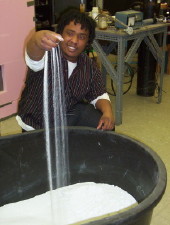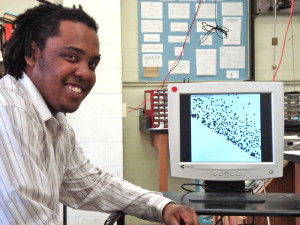

Investigating Bagnold's Booming Sand Dune Theory
Through Computational Aided Approaches
Neil K. Coutinho '09
 |
 |
| Neil playing in the sand | The sand-simulator |
Abstract:
Booming sand is a rare natural phenomenon which manifests itself when an avalanche on a sand dune results in a continuous, loud droning sound. This acoustic emission is notable because it is composed of one dominant audible frequency ranging from 70 to 105 Hz. This study takes the approach of building computer simulations to model sand grains at the microscopic level to determine whether the synchronized movement of flowing sand grains in the avalanche, as proposed by Bagnold, is primarily responsible for booming. A Mathematica model was developed to numerically integrate the coupled differential equations for a 1-dimensional model of avalanching grains. In addition, a Java based 2-dimensional rendering of idealized sand grains collisions was also used to investigate oscillatory motion for replicated optimal booming dune conditions. Findings from the 1-D model, though showing well-defined peaks at certain frequencies, are not in agreement with those predicted by Bagnold’s. However a proportional relationship between frequency and linear concentration was observed, inline with Bagnold’s model. Simulated unfavorable booming conditions, such as rigidity in the packing structure and variably sized particles, seemed to indicate loss in the booming effect. The 2-D Java rendering currently accurately simulates grain collision, however recent data is inconclusive to suggest any synchronized motion in the avalanching layer. Further development of this simulation is required before any viable data can be analyzed.
For more information, contact Dr. Brian Watson:
Return To 2009 Senior Projects
|
|
||
| © | St. Lawrence University | Department of Physics |
| Revised: 13 May 2009 | Canton, NY 13617 |